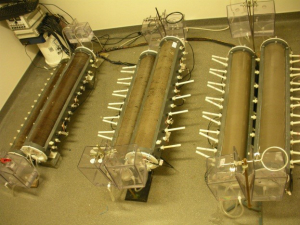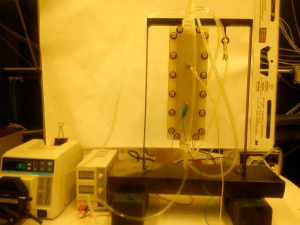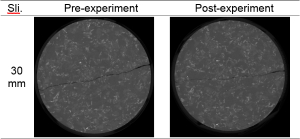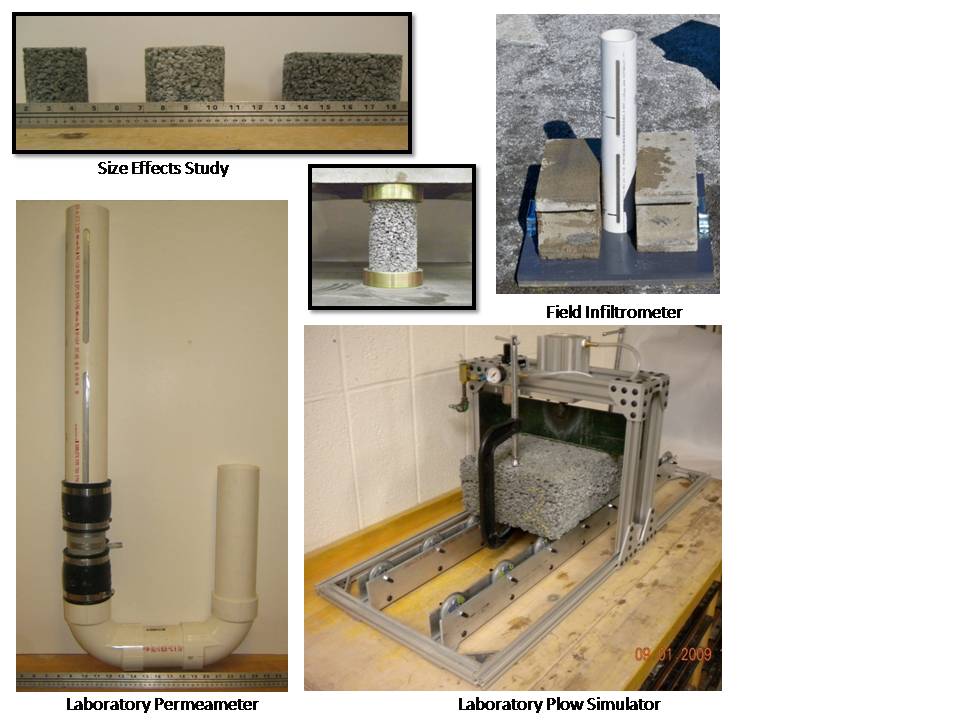
To address some of the pressing environmental, economic, and social challenges that we are facing as a global community, it is important to transition from fossil fuel to renewable energy-based infrastructure and make our natural and built infrastructure as sustainable as possible. Our current research in this area focuses on exploring different sources of renewable energy, bio-inspired materials, smart growth, and integrating sustainability in the design of civil infrastructure systems.
Research Project: Quantifying Second-by-second Driving Style for Tailpipe Emissions Modeling

Co-PI: Britt Holmen (UVM CEE), Karen Sentoff, Jon Dowds and Jim Sullivan (UVM Transportation Research Center), Eric Jackson (UConn)
Graduate Students Involved: Nathan Belz
Description: Mobile devices and GPS have allowed researchers to track human travel behavior including quantifying a driver’s second-by-second driving style. The differential engine load that accrues from different vehicle speeds, acceleration and road grades results in different levels of emissions, both greenhouse gasses and air toxics. Field data collection to understand driving style can not only help improve tailpipe emission models but also informs programs to promote countermeasures such as eco-driving.
Publications:
Sentoff, Karen, Lisa Aultman-Hall and Britt Holmén, Implications of Driving Style and Road Grade for Accurate Vehicle Activity Data and Emissions Estimates. forthcoming Transportation Research Part D.
Dowds, Jonathan, James Sullivan and Lisa Aultman-Hall. (2013) Seasonal Comparison of Discretionary Passenger Vehicle Idling Behavior using GPS and OBD Devices. Transportation Research Record.
Belz, Nathan* and Lisa Aultman-Hall (2011). Analyzing the Effect of Driver Age on Operating Speed and Acceleration Noise Using On-board Second-by-Second Driving Data. Transportation Research Record 2265 pp. 184-191.
Jackson, Eric* and Lisa Aultman-Hall (2010). Analysis of Real-World Lead Vehicle Operation for Integration of Modal Emissions and Traffic Simulation. Transportation Research Record Vol 2128.
The UVM team has tested emissions and driving style in both conventional and hybrid vehicles.
Research Project: Measuring Long Distance and Overnight Travel Behavior

Co-PI: Jeff LaMondia Auburn University and Chester Harvey UVM TRC
Graduate Students Involved: None
Description: Despite the relatively high contribution to greenhouse gas emissions especially from airplanes, long distance and overnight travel patterns are poorly understood and real world data is very limited. The UVM team has collected a one-year on-line survey of overnight long distance trips undertaken by participants in the United States and Canada. We are using this data to inform future survey design to better collect trips and to compare travel patterns between people and between work and leisure travel.
Publications:
LaMondia, Jeffrey, Lisa Aultman-Hall, and Elizabeth Greene. (2014) Long-distance Work and Leisure Travel Frequencies: An Ordered Probit Analysis of Stated Preference Data, Transportation Research Record, Volume 2413, pp 1-12.
Aultman-Hall, Lisa and Jeffrey LaMondia, Analyzing Changes in Response Quality from a One-Year Longitudinal Travel Survey, 10th International Conference on Transport Survey Methods: Embracing Technological and Behavioral Changes, November 16-21, 2014 in Leura, Australia.
Circles indicate the relative number of travel destinations for 229 Vermonters surveyed in 2013.
Research Project: Quantitative Environmental Risk Assessment of Energy Extraction from Deep Shale Formations

PI: George Pinder
Co-PI: None
Undergraduate Students Involved: James Montague and Anna Waldron
Description: Hydrofracking to enhance the permeability of low permeability geological formations for petroleum resource recovery entails the creation of fractures to enhance the flow of petroleum fluids. If such fractures encounter pre-existing well bores that provide access to potable aquifers, there is the possibility of groundwater contamination. This project seeks to use existing field information in combination with risk analysis to assess the probability of such contamination occuring.
Publications:
None, one is in review.
Research Project: Emissions and Performance of Alternative Vehicles: Hybrid-Electric Passenger Cars Under Real-World Driving
PI: Britt A. Holmén
Co-PI: None
Graduate Students Involved: Matthew Conger (M.S.) , Karen Sentoff (M.S.), Mitchell Robinson (M.S.)
Description: Very little real-world data existing on how hybrid-electric passenger cars perform under real-world driving, especially for places like Vermont with hilly terrain and cold climate. We designed and built the Total On-board Tailpipe Emissions Measurement System (TOTEMS) to collect vehicle emissions and performance data on two Toyota Camry vehicles – one conventional vehicle (CV) and one hybrid-electric vehicle (HEV). This is the first data comparing CV and HEV passenger cars of the same vehicle model, thus accounting for vehicle aerodynamics and size. Data collected over an 18-month sampling period are being analyzed to answer the following questions:
- What vehicle operating modes result in significant differences in particle- and gas-phase exhaust emissions between the conventional and hybrid-electric vehicles?
- How do particle number distributions vary with operating mode?
- What are the real-world fuel consumption advantages of the HEV compared to the CV?
- Are the air toxic emissions from both vehicles similar? If not, why not?
- How do tailpipe greenhouse gas emissions vary with vehicle type, ambient temperature and road grade?
Publications:
Sentoff, Karen and Britt A. Holmén, (2014) Fuel Economy Benefit of a Hybrid-Electric Light-Duty Vehicle across Real-World Operating Modes. 93rd Annual Meeting of the Transportation Research Board, January 2014, Washington, DC. Paper No. 14-4583.
Conger, Matthew and Britt A. Holmén (2012) Real-World Engine Cold Start and “Restart” Particle Number Emissions from a 2010 Hybrid and Comparable Conventional Vehicle. Transportation Research Board 91st Annual Meeting, Washington, D.C., January 2012, Paper No. 12-4570.
Robinson, Mitchell K. and Britt A. Holmén (2011) Onboard, Real-World Second-by-Second Particle Number Emissions from 2010 Hybrid and Comparable Conventional Vehicle. Transportation Research Board 90th Annual Meeting Washington D.C. 2011, Paper No. 11-1775.
Research Project: Electrically Enhanced Oil Recovery in Geological Formations
PI: Ehsan Ghazanfari
Co-PI: None
Graduate Students Involved: Maria Peraki
Description: Electrically Enhanced Oil Recovery (EEOR) is a new technique that has great potential in resource recovery specifically in heavy oil reservoirs. We are conducting laboratory investigation on natural and synthetic cores o understand the effect of petro-physical characteristics of formation (i.e., pore structure, constitutive relationships) on flow characteristics and important parameters affecting oil recovery in clay rich formations using state of the art tools. We are also developing a mathematical model to predict the two-phase flow under applied hydraulic and electric gradients based on the petro-physical properties of the formation and the physical/chemical properties of the crude oil.
Publications:
Peraki, M., Ghazanfari, E., Pinder, G.F., Harrington, T.L. (2016) "Electrodialysis: An Application for the Environmental Protection in Shale-gas Extraction". Journal of Separation and Purification, Vol. 161, pp 96–103
Peraki, M., Ghazanfari, E. (2014), "Electrodialysis Treatment of Flow-back Water for Environmental Protection in Shale Gas Development", ASCE Shale Energy Eng. Conference, Pittsburgh, PA, 2014


Investigation of Coupled Processes Within Fractures in Enhanced Geothermal Systems

PI: Ehsan Ghazanfari
Co-PI: None
Graduate Students Involved: Robert Caulk, Arash Kamali-Asl
Description: The success and sustainability of an EGS depends strongly on the permeability of its fracture network. As the geothermal fluid circulates between the injection and production wells through existing or man-made fractures, it interacts with the reservoir rock, and triggers coupled Thermal-Hydro-Mechanical-Chemical (THMC) processes that impact reservoir dynamics and productivity. Change in fracture aperture and permeability due to coupled processes caused by fluid injection/extraction operations could significantly affect the EGS production success. We are conducting laboratory experiments on fractured granite specimens at reservoir conditions to investigate how the coupled processes affect the fracture aperture and permeability evolution at EGS reservoir, and improving the predictive capability of existing models using well-constrained experimental laboratory data.
Publications: Caulk, R., Ghazanfari, E., Perdrial, J., Perdrial, N. (2015). "Experimental Investigation of Fracture Aperture and Permeability Change within Enhanced Geothermal Systems". Geotherimcs, (In review)

Research Project: Feasibility of Pervious Concrete Pavements for Northern Climates
PI: Mandar Dewoolkar
Co-PI: None
Graduate Students Involved: George McCain, Mark Suozzo, Ian Anderson, Jennifer Fitch, Bradford Berry
Undergraduate Students Involved: Bradford Berry
Description: Pervious concrete pavements (PCP) provide an environmentally conscious alternative to traditional pavement systems and have been identified as an effective management practice for treating stormwater. PCP allows stormwater to pass though the surface material, reducing runoff and removing contaminants such as nutrients and heavy metals. PCP has additional benefits including, reducing noise from vehicles, improving skid resistance and reducing heat island effects. Despite the benefits, the potential for lower compressive strength, clogging, raveling and susceptibility to freeze-thaw and salt damage has limited the use of pervious pavements especially in cold environments. Our research evaluated the mechanical and hydraulic behavior of PCP with various mix designs and additives (e.g. sand, fly ash, slag, slag with silica fume) in laboratory; assessed freeze-thaw durability and resistance to deicing salt; and monitored field performance of multiple sites in Vermont including one instrumented site on UVM campus. The research was funded by the UVM Transportation Research Center and the Vermont Agency of Transportation.
Publications:
Anderson, L., and Dewoolkar, M. M. (2015), "Durability of fly ash pervious concrete for freeze-thaw in a simulated field environment", ACI Materials Journal, 112(5), 603-611.
Suozzo, M. J., and Dewoolkar, M. M. (2014), "Evaluation of strength and hydraulic testing methods of pervious concrete", ACI Materials Journal, 111(1), 23-34.
Suozzo, M. J., and Dewoolkar, M. M. (2012), "Long-term field monitoring and evaluation of maintenance practices of pervious concrete pavements in Vermont", Transportation Research Record, No. 2292, Maintenance and Preservation, 94-103.
McCain, G. N., and Dewoolkar, M. M. (2010), "Porous concrete pavements: mechanical and hydraulic properties", Transportation Research Record, No. 2164, Washington D.C., 66-75.
Berry, B., Suozzo, M. J., Anderson, I. A., and Dewoolkar, M. M. (2012), "Properties of pervious concrete incorporating recycled concrete aggregate", TRB Annual Meeting. paper 12-3994.
McCain, G. N., Suozzo M. J., and Dewoolkar, M. M., (2010) “A laboratory study on the effects of winter surface applications on the hydraulic conductivity of porous concrete pavements”, Transportation Research Board 2009 Annual Meeting, 2010 - publication and poster presentation.

